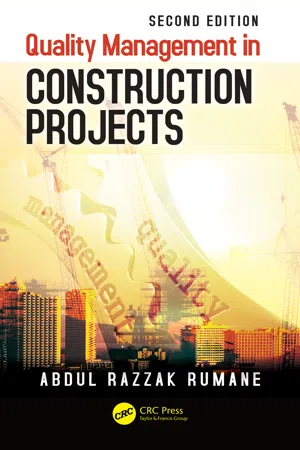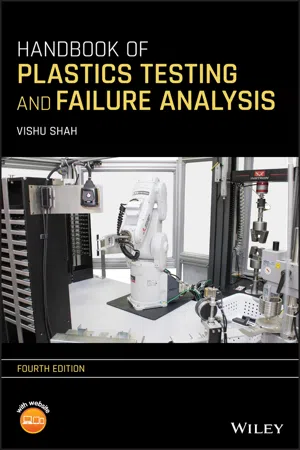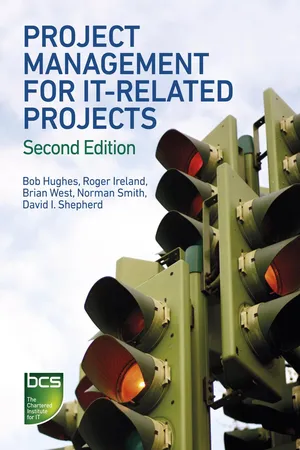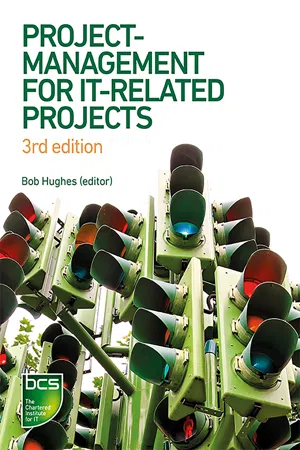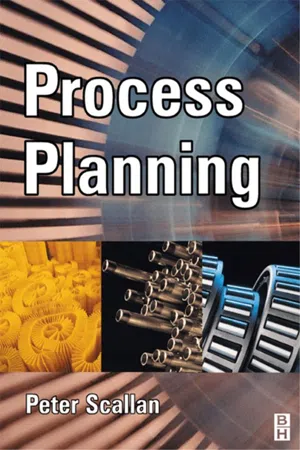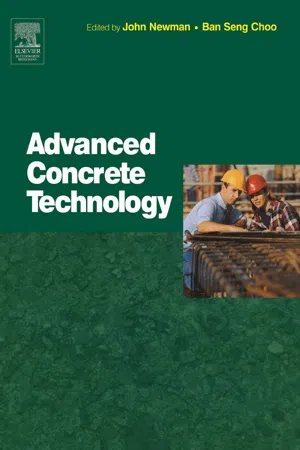Technology & Engineering
Quality Control
Quality control is a process that ensures products meet specific standards and requirements. It involves monitoring and testing products during and after production to identify and address any defects or deviations from the desired quality. By implementing quality control measures, companies can maintain consistency and reliability in their products, ultimately leading to customer satisfaction and trust.
Written by Perlego with AI-assistance
Related key terms
8 Key excerpts on "Quality Control"
- eBook - ePub
- Abdul Razzak Rumane(Author)
- 2017(Publication Date)
- CRC Press(Publisher)
(Source : Feigenbaum, A.V. (1991), Total Quality Control, Reprinted with permission of The McGraw-Hill Education.) Quality engineering becomes the field, or apex, of the triangle. The technical work area of the discipline—quality systems implementation—is shown in the first tier. The second tier then shows the principal techniques of quality engineering technology. Quality engineering relates the particular requirements of the plant and companies to the available quality technology—including both hardware equipment and planning and control actions—to put in place much of the ongoing operating detail of the quality systems framework for the firm. Quality engineering technology thus provides the technical areas to deal with such questions as the following: What are the specific details of the control activities to take place during the development and production and service cycles? Will these quality activities best be accomplished through the use of quality information equipment or by the use of people guided by procedures? What information and material inputs will be needed? What type of information data is required? How should it be analyzed, and what sort of feedback should be used? Depending upon the differences in the product-quality levels encountered, what criteria are there for alternative courses of corrective action? Feigenbaum (1991) has further elaborated the entire range of techniques used in quality engineering technology by grouping them under three major headings: Formulating of quality policy. Included here are techniques for identifying the quality objectives and quality policy of a particular company as a foundation for quality analysis and systems implementation. Product-quality analysis. Techniques for analyzing include those for isolating and identifying the principal actors that relate to the quality of the product in its served market - Vishu Shah(Author)
- 2020(Publication Date)
- Wiley(Publisher)
16 Quality Control16.1. INTRODUCTION
Quality, as defined by the American Heritage Dictionary, is a characteristic or attribute of something, property, or a feature. According to Juran (1 ), “Quality is a universal concept, applicable to all goods and services, more appropriately described as fitness for use.” Fitness for use is the extent to which the product successfully serves the purpose of the user during usage. Quality Control is the regulatory process through which we measure actual quality performance, compare it with standards, and act on the difference (2 ).Quality Control is the means by which every step in the production process receives the attention required to ensure that all parts and end products meet the desired specifications. Some parts are so complicated that if a production machine introduces a minor variance, the end unit cannot be assembled. This means that the manufacturer must make a determination of every critical step of the manufacturing process. Then, he or she must decide at which point inspections will be made and what controls will be established in order to produce parts and end products with all of the desired specifications.In these days of rules and regulations, the only way any manufacturer can survive and be profitable is to have a firm grasp and a clear understanding of the science of Quality Control. For a plastics manufacturer or processor, the challenge is unique. The majority of materials are newly developed and are not precise in their composition. Manufacturing processes and procedures are different from conventional techniques; products made from such new materials have no previous history. Finally, the rapid growth of the plastics industry has crated severe problems in training new people.Interdependence of major variables in controlling product quality.Figure 16‐1.A well‐established Quality Control system serves many useful purposes. First, it keeps the present customer happy, which in turn attracts new business. Second, it allows one to meet all regulatory and contractual obligations. More important, the system acts as a signaling device for any unforeseen problems and thereby reduces costly rejects. In the case of plastics, controlling the quality of the product is not a simple matter of inspecting and testing the product as it comes off the machine or assembly line. Many variables and unknowns, such as post‐mold shrinkage, play an important role in controlling the ultimate quality of the product. Figure 16‐ ,1- eBook - ePub
- Bob Hughes, Roger Ireland, Brian West, Norman Smith, David I. Shepherd, Bob Hughes(Authors)
- 2012(Publication Date)
- BCS, The Chartered Institute for IT(Publisher)
The methods for exercising Quality Control are discussed in detail later, but generally these tend to take the form of a review. Quality assurance stands alongside reviews but is external to them. Quality assurance is like an audit. It is designed to confirm that proper procedures are in place and have been applied correctly. The difference between the two can be illustrated by the following example. A metal rod must be 15mm in diameter (± 0.1mm). Control is achieved by passing each rod through a measuring device which triggers rejection if the rod is out of tolerance. Assurance is exercised by checking that the measuring device is accurate and that all rods go through it.For each component, quality criteria are specified. As we have seen above, this is in effect the first part of Quality Control, for without the criteria no control can take place. A control process is then undertaken to ensure that the criteria have been met. This is followed, at an appropriate time, by an assurance process which confirms that the agreed procedures have been followed and that all products have undergone the necessary checks.You will recall from Chapter 1 that the systems development life cycle has a number of stages – for example, requirements analysis is followed by systems design, followed by construction and testing. Each stage contains several Quality Control processes, in the form of some sort of review, and a quality assurance process takes place at the end of each stage. If proper Quality Control is lacking, corrective action may be mandated. The Quality Control and, if necessary, the quality assurance processes are repeated until the quality criteria are met.5.6 QUALITY PLANThe production of a quality plan is vital to the success of a project. It specifies the particular standards that apply to the project. They could be existing standards – for example, laying down the content and layout of product definitions. Modifications to existing standards may be needed because of the special characteristics of a new project. In some cases they could be completely new, as a project goes into territory not previously explored. The standards may derive from industry standards or be developed internally. If there are any gaps, then the project manager must ensure that the appropriate standards are specified.The plan also specifies how, when and by whom the Quality Control activities should be undertaken, the quality assurance processes to be followed and who will carry them out. It may also include configuration management and change control procedures (see Chapter 4 - eBook - ePub
Engineering Your Future
The Professional Practice of Engineering
- Stuart G. Walesh(Author)
- 2012(Publication Date)
- Wiley(Publisher)
Quality Control AND QUALITY ASSURANCEBack to the importance of defining quality, the Quality Management Task Force of the Construction Industry Institute says “Quality is conformance to established requirements.” Some advice, from industrialist Henry J. Kaiser, about what to do when you have provided quality: “When your work speaks for itself, don’t interrupt.” English writer John Ruskin said “Quality is never an accident, it is always the result of intelligent efforts.” And finally, this more philosophical thought, from minister and writer Ralph Waldo Emerson, that suggests thinking more about quality as we contemplate our daily expectations: “To affect the quality of the day, that is the highest of arts.”The American Society of Civil Engineers (ASCE 2000) defines Quality Control (QC) as “the review of services provided and completed work, together with management and documentation practices, that are geared to ensure that project services and work meet contractual requirements.” The “what” might be checks, reviews, inspections, tests, and verifications. Each of the “whats” is carried out against a standard or expectation. For example, “All plan sheets will be reviewed by an experienced engineer not directly involved in the project” or “Digital photographs (close up and vicinity view) will be taken of all survey monuments” (Henstridge, 2006).ASCE (2000) defines quality assurance (QA) as “planned and systematic actions focused on providing the members of the project team with confidence that components are designed and constructed in accordance with applicable standards and as specified by contract.” For example, providing initials and dates indicating which experienced engineer, not directly involved with the project, actually reviewed the plan sheets or requiring a sign off when verifying files containing digital photographs of all survey monuments. The American Society for Quality (2011) uses these definitions (quoted): - eBook - ePub
Project Management for IT-Related Projects
3rd edition
- Bob Hughes, Roger Ireland, Brian West, Norman Smith, David I. Shepherd, Bob Hughes(Authors)
- 2019(Publication Date)
- BCS, The Chartered Institute for IT(Publisher)
Quality Control would normally be an integral part of the project team’s work. The quality assurance activities, on the other hand, are usually carried out by people outside the project team who report directly to the steering committee/project board. This separation of responsibilities helps to ensure that the process is transparent and reduces possible conflicts of interest.Quality criteria are specified for each component. As each component is completed, a control process is undertaken to ensure that the criteria have been met. This is followed, at an appropriate time, by an assurance process which confirms that the agreed procedures have been followed and that all products have undergone the necessary checks.You will recall from Chapter 1 that the systems development life cycle has a number of stages – for example, requirements analysis is followed by systems design, followed by construction and testing. Each stage contains Quality Control processes, usually reviews, and a quality assurance process takes place at the end of each stage. If proper Quality Control is found to be lacking, corrective action may be mandated. The Quality Control and, if necessary, the quality assurance processes are repeated until the quality criteria are met.5.6 QUALITY PLANNING
The creation of a quality plan is vital to the success of a project. It specifies the particular standards that apply to the project. Ideally, they should be taken from existing organisational standards. These in turn may derive from industry standards. However, modifications to organisational standards may be needed because of the special characteristics of a project.The plan also specifies how, when and by whom the Quality Control activities should be undertaken, the quality assurance processes to be followed and who will carry them out. It may also include configuration management and change control procedures (see Chapter 4 - eBook - ePub
Process Planning
The Design/Manufacture Interface
- Peter Scallan(Author)
- 2003(Publication Date)
- Butterworth-Heinemann(Publisher)
Fig. 8.2 illustrates how inspection is used to identify problems with any of the three phases and move towards the unachievable goal of zero defects as defined by the philosophy of just-in-time (JIT).Figure 8.2 Closed-loop Quality Control in manufacturingHowever, any quality system in manufacturing should be about more than just control. The system should be able to answer four basic questions (Price, 1989 ):Can we make it OK?
This is focusing on the capability of the processes employed in the manufacture of the product.Are we making it OK?
This is focusing on process Quality Control as illustrated in Fig. 8.1 and is checking to make sure the process is correct, that is, inspection.Have we made it OK?
This is basically about quality assurance and is addressing all activities in the loop and trying to prevent errors.Could we make it better?
Whereas the first three questions are addressing the first objective of setting and maintaining performance standards, this question is addressing the issue of continuous improvement. In the context of this chapter, the focus is firmly on answering the first two questions and is therefore concerned with process capability and control.8.4 Statistical Quality Control
8.4.1 What is statistical Quality Control?The focus for the process planner is on selecting processes, equipment and tooling that ensures the product conforms to the specifications, which, in turn, requires process control and capability. Therefore, the focus is on statistical Quality Control (SQC), which has been firmly established since the 1940s (see Section 8.3.1 for history). Referring back to our manufacturing-based definition of quality, SQC is about employing inspection methodologies derived from statistical sampling theory to ensure conformance to requirements (Nicholas, 1998 ). The samples are inspected from a batch and allow conclusions to be drawn on the whole batch based on statistical inferences. Although there are a number of SQC tools and techniques, some of which are outlined in Section 8.4.4 - Yasar A. Ozcan(Author)
- 2017(Publication Date)
- Jossey-Bass(Publisher)
Chapter 12 Quality Control and ImprovementLearning Objectives
- Describe the meaning of quality and Quality Control in health care.
- Review measures of quality in various health care operations.
- Recognize process variability and randomness concepts.
- Develop quality monitoring and control charts.
- Analyze Quality Control charts for a health care situation.
- Describe and analyze control chart patterns.
- Describe quality improvement techniques.
Quality in Health Care
Quality in general terms means meeting and exceeding customer expectations. In health care, the definition of customer and the criteria for quality are complicated matters in comparison to the meaning of those terms in industry. Obviously, it is patients who receive health care services. However, what they receive is often not understood by them when diagnosis and therapy are purchased on their behalf by providers. Hence, quality in health care is evaluated from differing perspectives of recipients and third-party payers.Most clinicians accept the Institute of Medicine (1990) definition: “Quality is the extent to which health services for individuals and populations increase the likelihood of desired health outcomes and are consistent with current professional knowledge.” In accordance with this definition, health care organizations have developed many valid technical measures to evaluate diagnostic and therapeutic clinical processes. A different set of measures is based on health care outcomes that become available or are obtained at the same time or after health services were rendered. If the outcomes can be related to a process or series of processes known to improve outcomes, they also are considered to be valid measures of quality. However, an outcome measure that is related to patients' or clinicians' experience, particularly their feelings about processes (collected using satisfaction surveys), is defined as a subjective perception about the quality of care (Chassin, 1998).- eBook - ePub
- John Newman, B S Choo(Authors)
- 2003(Publication Date)
- Butterworth-Heinemann(Publisher)
8Quality concepts
Patrick Titman8.1 Introduction
The ACT syllabus embodies the truth that technical knowledge and expertise are of limited value unless they are linked to management expertise. Part of the approach to this expertise is an understanding of the various management systems expected to operate – quality, environment, health and safety – and of how these systems apply in different parts of the construction industry. For a firm to be successful it must have people able to be sympathetic to and to relate the firm to the needs of its customers. This chapter addresses these issues.8.2 Definitions
Formal definitions of quality management terms are given in ISO 9000:2000 Quality management systems – fundamentals and vocabulary . These can be expressed in the simple terms below:Quality Meeting requirements. Quality management The means we devise for meeting requirements. Quality Control The means of knowing (monitoring) where we are relative to meeting requirements. Quality assurance The assurance we give ourselves and others – customers, shareholders, regulators – that quality is being provided. Audit Independent enquiry to examine whether the management is appropriate and whether quality is being achieved. But what is really useful is to understand the relationship between the five concepts. They make a pattern like the clock in Figure 8.1
Index pages curate the most relevant extracts from our library of academic textbooks. They’ve been created using an in-house natural language model (NLM), each adding context and meaning to key research topics.
